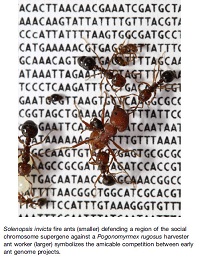
Alain Lenoir Mis à jour 30-Jul-2023
Dans les années 2000 on avait commencé l'analyse du génome de diverses fourmis, mais sans suite (Astruc et al 2004)
En 2015, 10 génomes
de fourmis étaient séquencés, voir un article de synthèse
(Nygaard and Wurm 2015) :
- Linepithema humile (Smith et al 2011),
- Ooceraea (Cerapachys) biroi (Oxley et al 2014)
- Camponotus floridanus (Bonasio et al 2010)
- Formica selysi (Purcell et al 2014)
- Acromyrmex echiniator (Nygaard 2011)
- Atta cephalotes (Suen et al 2011)
- Cardiocondyla obscurior (Schrader et al 2014)
- Pogonomyrmex barbatus (Smith et al 2011)
- Solenopsis invicta (Wurm et al 2011)
- Harpegnathos saltator (Bonasio et al 2010)
En 2018 on était déjà à 23 espèces (Favreau 2018).
Global Ant Genomics Alliance (GAGA), un projet de génome des fourmis du monde (Genome Sequences for the Ant Genera of the World) pour obtenir le génome de 200 espèces de fourmis, incluant leur microbiote (Boomsma et al 2017).
Génome
mitochondrial
Chez Formica sinae, le génome mitochondrial est long de 1 256
paires de bases incluant 13 gènes codant pour des protéines (PCGs),
22 gènes de RNA transfert (tRNAs), 2 gènes de ribosomses (rRNAs)
et 1 gène de contrôle. 48 espèces de fourmis ont aussi été
séquencées. Formica sinae est très proche de F.
fusca et F. selysi (Zhang et al 2022).
Voir
un plus gros article sur l'ADN mitochondrial de Pachycondyla replacé
dans la phylogénie des fourmis (Lin & Song 2023).
On commence à s'intéresser aux capacités d'adaptation des espèces à l'environnement urbain par l'étude de leur génome. Si l'on compare le génôme de Lasius niger, de Camponotus floridanus et autres espèces séquencées il apparait que celui de L. niger est plus riche en gènes de réparation de l'ADN, en éléments transposables, en gènes de détoxyfication (glutatione-S-transférase et cytochromes de la famille P450, dont le CYP9) parmi d'autres. Cela expliquerait le succès de la fourmi noire des jardins en ville (Konorov et al 2017).
Voir
- Astruc C., Julien J.-F., Errard C. Lenoir A. (2004) – Molecular phylogeny
in the Formicidae family. Molecular Phylogenetics and Evolution, 31, 880-893.
Pdf
- Bonasio, R., G. Zhang, C. Ye, N. S. Mutti, X. Fang, N. Qin, G. Donahue, P.
Yang, Q. Li, C. Li, et al. (2010). Genomic Comparison of the Ants Camponotus
floridanus and Harpegnathos saltator. Science 329(5995): 1068-1071.
-J.J.Boomsma,
S., G.Brady, R.R.Dunn, J.Gadau, J.Heinze, L.Keller, N.J.Sanders, L.Schrader,
T.R.Schultz, L.Sundstöm, P.S.Ward, W.T.Wcislo, G.Zhang, The GAGA Consortium
(2017). The Global Ant Genomics Alliance (GAGA). Myrmecological News 25, 61-66
- Favreau, E., C. Martínez-Ruiz, L. Rodrigues Santiago, R. L. Hammond
and Y. Wurm (2018). Genes and genomic processes underpinning the social lives
of ants. Current Opinion in Insect Science 25: 83-90. https://doi.org/10.1016/j.cois.2017.12.001
- Konorov, E. A., M. A. Nikitin, K. V. Mikhailov, S. N. Lysenkov, M. Belenky,
P. L. Chang, S. V. Nuzhdin and V. A. Scobeyeva (2017). Genomic exaptation enables
Lasius niger adaptation to urban environments. Bmc Evolutionary Biology 17(Suppl
1): 39. 10.1186/s12862-016-0867-x
-
Lin, X. and N. Song (2023). The First Complete Mitochondrial Genome of the Genus
Pachycondyla (Formicidae, Ponerinae) and Insights
into the Phylogeny of Ants. Genes 14: 1528. 10.3390/genes14081528
- Oxley, Peter R., L. Ji, I. Fetter-Pruneda, Sean K. McKenzie, C.
Li, H. Hu, G. Zhang and Daniel J. C. Kronauer (2014). The Genome of the
Clonal Raider Ant Cerapachys biroi. Current Biology. http://dx.doi.org/10.1016/j.cub.2014.01.018
- Nyygaard S. (2011). The genome of the leaf-cutting ant Acromyrmex echinatior
suggests key adaptations to advanced social life and fungus farming. –
Genome Research 21: 1339-1348.
- Nygaard, S. and Y. Wurm (2015). Ant genomics (Hymenoptera: Formicidae): challenges
to overcome and opportunities to seize. Myrmecological News 21: 59-72.
- Purcell, J., A. Brelsford, Y. Wurm, N. Perrin and M. Chapuisat (2014). Convergent
Genetic Architecture Underlies Social Organization in Ants. Current Biology
24(22): 2728-2732. http://dx.doi.org/10.1016/j.cub.2014.09.071
- Schrader, L., J. W. Kim, D. Ence, A. Zimin, A. Klein, K. Wyschetzki, T. Weichselgartner,
C. Kemena, J. Stökl, E. Schultner, et al. (2014). Transposable element
islands facilitate adaptation to novel environments in an invasive species.
Nat Commun 5. 10.1038/ncomms6495
- Smith, C.D et al (2011). Draft genome of the globally widespread and invasive
Argentine ant (Linepithema humile). – Proceedings of the National Academy
of Sciences of the United States of America 108: 5673-5678.
- Suen, G., C. Teiling, L. Li, C. Holt, E. Abouheif, E. Bornberg-Bauer, P. Bouffard,
E. J. Caldera, E. Cash, A. Cavanaugh, et al. (2011). The Genome Sequence of
the Leaf-Cutter Ant Atta cephalotes Reveals Insights into Its Obligate
Symbiotic Lifestyle. PLoS Genet 7(2): e1002007.
- Wurm, Y., J. Wang, O. Riba-Grognuz, M. Corona, S. Nygaard, B. G. Hunt, K.
K. Ingram, L. Falquet, M. Nipitwattanaphon, D. Gotzek, et al. (2011). The genome
of the fire ant Solenopsis invicta. Proceedings of the National Academy
of Sciences, 108:5679-5684.
-
Zhang, X.-M., T. Li, X. Liu and Z.-H. Xu (2022). Characterization and Phylogenetic
Implication of Complete Mitochondrial Genome of the Medicinal Ant Formica sinae
(Hymenoptera: Formicidae): Genomic Comparisons in Formicidae. Journal of Medical
Entomology. doi: 10.1093/jme/tjac128. (article payant)